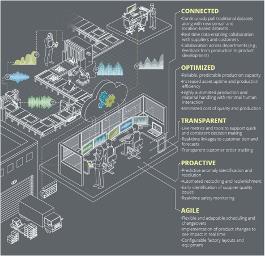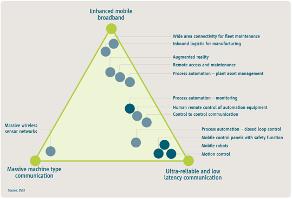This is primarily based on its low latency attributes, which provide the level of network responsiveness needed for real-time automation and control applications. In this article we review 5G in the context of Industrial Automation, (IA), consider some emerging applications, and ask the question of whether the reality will match the hype?
The concept of Industry 4.0, or the fourth industrial revolution was originally developed by the German government. It aimed to support GDP growth through the exports of German made machinery and equipment into an increasingly competitive industrial market. A market characterised by increased levels of globalization, urbanization, individualization, and demographic change.
These megatrends have been amplified by the ongoing pandemic and consequent upheaval, underlining the importance of operational agility, and causing manufacturers to accelerate their reliance on, and investment in digital technologies.
At the heart of Industry 4.0, is the smart factory, utilising flexible, modular, and versatile production techniques to improve efficiency whilst maintaining output and quality (figure 1). The smart factory replaces traditional static, sequential production systems with flexible processes. It combines human expertise with emerging technologies such as robotics, artificial intelligence, (AI), quantum computing, the industrial internet of things, (IIoT), 5G wireless technologies, and 3D printing.

Figure 1: Industry 4.0 is based on the smart factory (Source: Deloitte)
Many factories are constrained by the limitations of existing wired networks using communication protocols such as Industrial Ethernet, Profinet, and CANbus which connect the various sensors, actuators, and controllers found in automated production systems. These hard-wired solutions cause relatively inflexible control architectures, where even small modifications to production facilities can mean time-consuming and costly plant reconfigurations. Industry 4.0 needs powerful and efficient wireless communications which can deliver the latency, availability, jitter, and deterministic requirements of the smart factory. Industry 4.0 needs 5G!
Diverse and heterogeneous, the manufacturing environment encompasses a broad range of automation use cases, falling into 5 categories:
- Factory automation
- Process automation
- Human-machine interfaces (HMIs) and production IT
- Logistics and warehousing
- Monitoring and predictive maintenance
Many of these use cases require real-time responsiveness and latency, which previous generations of wireless networks have been unable to deliver. Also, the factory floor is a difficult operating environment, with high levels of electrical noise and interference challenging many previous wireless communications technologies. 5G’s enhanced networking performance (figure 2) can be used to address some of these issues, increasing system efficiency and flexibility.

Figure 2: 5G’s networking capabilities support a broad range of industrial use cases (Source: 5GACIA)
Monitoring is a key function within the automated factory and 5G’s Massive Machine-Type Communications (mMTC) capability is ideally suited to the requirements of large-scale wireless sensor networks (WSN), with high numbers of connected devices, where long battery life, (and hence low power communications), is a critical feature that avoids time consuming maintenance.
Motion control and industrial robotics require precision and real-time responsiveness, driving the trend towards Time-Sensitive Networking (TSN) for (wired) Industrial Ethernet solutions. With its reliability and ultra-low latency 5G’s Ultra-Reliable Low-Latency Communication (URLCC) now provides a viable wireless alternative for these applications and enables Cloud Robotics.
Virtual Reality, Augmented Reality & Artificial Intelligence, (VR/AR/AI) are three related technologies used increasingly within the factory environment particularly in areas such as product prototyping, training and maintenance and machine-learning. 5G’s high throughput and low latency enables true cloud-edge processing, where energy-intensive computations can be done in the cloud using less complex, lower-cost devices connected at “the edge” – on the factory floor.
Implementing 5G is not without its challenges. To ensure the protection of prior investments, 5G projects must integrate seamlessly into existing communications infrastructure. Indoor coverage has never been a priority for Mobile Network Operators, (MNOs) and this is made worse by the propagation characteristics of 5G frequencies – particularly in factories which have a challenging radio frequency, (RF) environment.
Developments in Open-RAN technologies are reducing the cost of ownership of 5G Radio Access Networks, (5G RAN), making Non-Public Network, (NPN), deployments a realistic option for businesses – either directly or through a growing number of specialist systems integrators. Regulators around the world are recognising the importance of NPNs in the 5G roll-out and are making a dedicated cost-effective spectrum available for those who prefer this option.
An NPN can be designed to meet the specific operational needs of the factory but can also mix and match network functionality between the NPN and the 5G network of their MNO. For example, the NPN can be completely isolated from the public network, but it can share the RAN with the public network. It can also share the RAN and Control Plane functionality, or, in some cases, be completely hosted by the MNO.
Increased levels of automation in the industrial sector have created demand for the capabilities of 5G networks. As production runs shorten and manufacturers manage the demands of customisation and expected speed-to-market, 5G enables the flexibility of wireless deployments without compromising throughput or responsiveness.
Next time: This is the second of a series of 4 blogs looking at 5G. Next week - The Connected Car Will Drive the Roll-out of 5G












